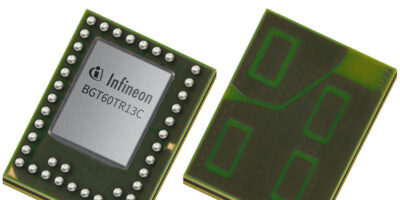To research sleep patterns and difficulties, Infineon Technologies has collaborated with Swiss digital health company, Sleepiz to offer a sleep monitoring system for use at home.
Sleep apnea, interrupted breathing, can cause daytime fatigue, as well as more difficult issues such as heart problems and diabetes. Diagnosing sleep apnea often includes observing a patient in a sleep laboratory. The two companies have collaborated to produce a sleep monitoring for use at home. The system can be integrated into any connected smart home device, from smart speakers to bed lamps. It is based on Infineon Xensiv 60GHz radar technology and Sleepiz algorithms.
According to Philipp von Schierstaedt, senior vice president and general manager Radio Frequency & Sensors at Infineon: “The Xensiv radar sensors allow the measurement of vital signs such as heartbeat and breathing rate without touching the body or intruding on privacy”.
“With Infineon’s decades of radar experience and our expertise in analysing respiratory and sleep-related diseases and disorders, we make sleep monitoring easy-to-use while delivering accurate data,” added Dr. Soumya Sunder Dash, CEO and co-founder of Sleepiz.
Understanding vital data can help millions of patients and doctors detect sleep disorders like apnea to improve sleep quality. The Xensiv 60GHz radar technology is used to collect relevant vital sign data contactless and anonymously without identifying the person. The high sensitivity of the technology means it can detect this data and sense sub-millimeter movements of the person closest to the device through various materials, such as blankets. Data is analysed with the help of machine learning (ML) algorithms from Sleepiz and stored anonymously in a cloud for the user to access.
As a medical device manufacturer Sleepiz is already selling medical sleep monitoring devices with Infineon’s radar technology to doctors in Switzerland and Germany today. Now the two companies would like to jointly revolutionise the consumer market and integrate their solution into smart speakers and other smart home devices.
Sleepiz AG was founded in 2018 by Marc Rullan, Max Sieghold and Soumya Sunder Dash as a spin-off from ETH Zürich. Sleepiz brings healthcare into homes and empowers patients to take charge of their own health. The company has developed a comfortable and cost-effective product to screen and diagnose sleep disorders like sleep apnea and to monitor patients with chronic diseases. The company has more than 50 employees across two continents and has received support from institutions like Innosuisse (Swiss Federal Innovation Agency) and the European Commission.
Infineon Technologies is one of the ten largest semiconductor companies worldwide.







